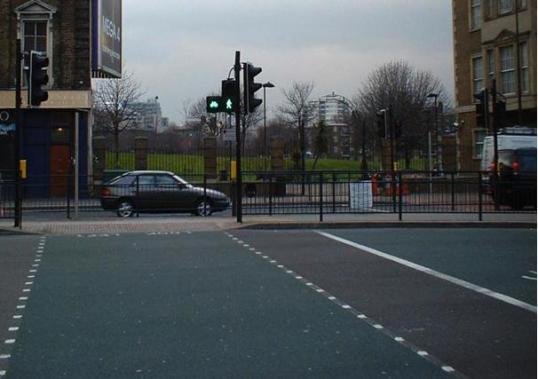Road design
- Education and training
- Land use planning
- Measures to reduce crash numbers and injury severity
- Protective devices: helmets
- Vehicle design of crash opponents
- Visibility: lighting and reflecting devices
Road design
Road design measures that assure a pedestrian-friendly and cyclist-friendly infrastructure, relate to:
The next four sections give a general overview of what they entail. More detailed information can be found in the ADONIS-manual[12] and in Design manual for bicycle traffic[10].
Pedestrian-friendly networks: area-wide speed reduction and safe walking routes
Area-wide speed reduction
Considering the relationship between collision speed and probability of death (see graph by Pasanen in Section 1.1), the probability of a fatal injury for a pedestrian reduces with decreasing collision speeds starting at a driving speed of about 80 km/h. At collision speeds below 30 km/h, encounters between motorised vehicles and pedestrians do not usually result in a fatality. One of the Sustainable Safety principles has been derived from this: where pedestrians and motorised vehicles meet, driving speeds of the latter must be reduced to 30 km/h.
In order to realize an area-wide reduction of driving speed in the short term, this speed reduction has to be forced on road users mainly by traffic engineering and infrastructural measures. Creating zones by road signs alone does not discourage drivers from driving faster than 30 km/h. Physical measures such as speed humps can force speed reduction [44], but can meet with opposition from bus and emergency vehicle drivers as well as from residents if extensive ground vibrations occur. In several countries, 30 km/h zones are implemented in residential areas or school zones. A Dutch evaluation of the effectiveness of these zones indicated that the introduction of these zones led to a reduction of about 10% in the number of fatalities per km road length and a reduction of 60% in the number of in-patients per km road length [57].
In the medium term, intelligent use of area-wide speed cameras might provide an alternative means of enforcement in some areas. In the longer term, extensive implementation of Intelligent Speed Adaptation should result in more direct compliance with speed limits.
Safe walking routes
'Kid routes' are special corridors of safe routes for guiding children for example to schools, play areas and sport facilities. These kid routes can mainly be found in busy residential areas. Since 2006 Delft and Amsterdam are the first municipalities in the Netherlands where children can use kid routes. The special child-friendly routes have a playful layout in which recognizable markings and boards lead children to their destination [11].
Cycling networks
Although cycle lanes have been found a good safety measure on road sections - provided the width of the track is sufficient and measures have been taken to prevent crashes with vehicles parking - there is evidence that they tend to create safety problems at intersections. Particular attention has to be given to the design of cycle routes at these locations. Crossings between cycle tracks and streets do not always seem well understood by drivers, in particular, when environmental features do not clearly reflect the right-of-way, thus creating confusion among drivers and cyclists alike [39]. Additional facilities are necessary at intersections in order to reduce the speed differences between cyclists and other traffic as much as possible. Priority regulations, speed humps, and raised intersections are suitable to achieve this [47].
Crossing facilities
Introducing crossing facilities does not necessarily reduce pedestrian and cyclist casualties. They need to be carefully designed and appropriately sited if they are to improve safety. Crossings at inappropriate sites can lead to confusion and unsafe behaviour by both motorists and pedestrians [33][60].
Feelings of mutual respect can be promoted by right-of-way regulations, speed reduction measures and improved visibility. Examples of speed reduction measures at cyclist crossings are raised cycle crossings, humps, refuges in crossings, and mini roundabouts. Important features for improvement of visibility are: truncated cycle tracks, advanced stop lines at signalised intersections, and parking regulations [60] .
Features of safer pedestrian crossings, in particular to allow for the specific limitations of the elderly pedestrian, include:
- Reducing the distance to be crossed by means of a median island and/or by sidewalk extensions;
- Equipping more pedestrian crossings with traffic lights;
- Allowing for the slower walking speed of the elderly when setting the traffic lights cycle;
- Reducing the speed of other traffic or banishing motorised vehicles completely in areas with many pedestrians [49].
At facilities used by both pedestrians and cyclists there must be only one rule: either both have priority, neither have priority, or both have traffic lights. Where they do have priority, this can be indicated by triangular priority marking just in front of the crossing facility, combined with an extended speed hump to ensure a low approaching speed. A quite long speed hump would slightly increase motorists' comfort because they can position the whole vehicle on the speed hump just in front of the crossing facility [48].
There is much to be said in favour of combining crossing facilities for pedestrians and cyclists, because a greater number of people crossing at one time reduces risk (see Risk and measurement of exposure). One possible method is the 'Toucan crossing' currently used in Great Britain [42] (see Figure 4). This crossing facility is named Toucan because both pedestrians and cyclists can use the same facility ('two can cross'). The advantage of a combined crossing is that it is more visible for fast-moving traffic travelling on the major road. In addition, Toucans can detect the numbers of crossing pedestrians and cyclists. These systems enable a fairer distribution of waiting times for fast and slow traffic, and they often establish shorter waiting cycles.
Figure 4 Toucan crossing. Source: C. Ford

